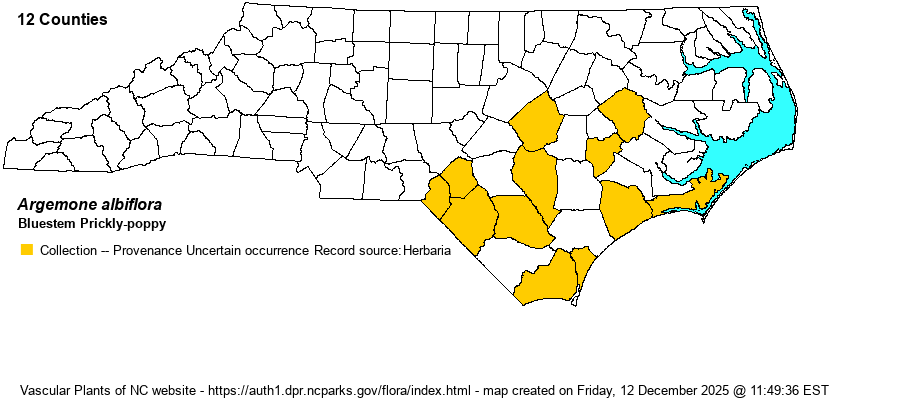| Author | Hornemann | |
| Distribution | Scattered in the southern half of the Coastal Plain, north to Johnston and Pitt counties. Traditionally it has been considered as an exotic species in NC, though Weakley (2024) considers it as native on his map; however, in his text he states "The species is apparently native to the southeastern United States, presumably including portions of our area [Southeastern US], south to s. FL, but the native range is unclear." In his monograph of the genus (Ownbey 1858) Ownbey states "In my opinion this taxon represents a relict northern Florida (sub)species which during rather recent times has spread along the coast both northward and weatward as a ruderal weed." In FNA, Ownbey does not indicate any native vs. non-native distribution.
This is a species of the southern Great Plains, perhaps native east to southeastern NC and all of FL. | |
| Abundance | Scarce, rare and greatly declining -- seemingly close to extirpation, but still extant in the southeastern corner of the state. It probably should be on the Watch List, to obtain recent records. The website editors suggest W4, to indicate that it might or might not be native, but provenance in NC is uncertain. One of the Website Editors (Sorrie) has never seen it in NC. The most recent specimen was collected in 2001 in Brunswick County, but there are recent iNaturalist photos from New Hanover and Brunswick counties. | |
| Habitat | In NC, all specimens are from sandy, open, disturbed sites, such as roadsides, fields, vacant lots, and waterfronts. These habitats suggest a non-native species, though equally suggest a naturally weedy native. Ownbey (1958) states that he "...has never seen it growing in indisputably natural circumstances." | |
| Phenology | Blooms in April and May, and rarely later; fruits shortly after flowering. | |
| Identification | This is an impossible species to overlook owing to its very large flower and prickly look. The herbaceous stem grows to about 1-1.5 feet tall, with some small prickles on it. The handful of scattered alternate leaves are elliptic to obovate in general shape, and about 4-5 inches long and 2 inches wide, somewhat cut and strongly prickly, with jagged margins. The stem and any branches are topped by a very large flower, with 4-6 white petals that are squared-off at the apex, and the spread flower is about 3 inches across. The numerous yellow stamens create a distinctive yellow center to the flower. | |
| Taxonomic Comments | Weakley (2018) considers that the taxon in the Southeast is the nominate one -- var. albiflora. Older references named the species as Argemone alba.
| |
| Other Common Name(s) | White Prickly-poppy | |
| State Rank | SE [SE?] | |
| Global Rank | G4G5 | |
| State Status | [W4] | |
| US Status | | |
| USACE-agcp | | |
| USACE-emp | | |

